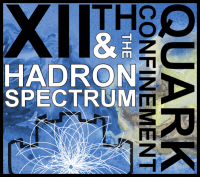Speaker
Description
Strong diquark correlations inside baryons is a consequence of two emergent phenomena in Quantum Chromodynamics (QCD): dynamical chiral symmetry breaking and confinement. That is to say, any interaction capable of creating pseudo-Goldstone modes as bound-states of a light dressed-quark and -antiquark, will necessarily also generate strong colour-antitriplet correlations between any two dressed quarks contained within a baryon.
The presence of these correlations must be evident in numerous empirical differences between the response of the bound-state's doubly- and singly-represented quarks to any probe whose wavelength is small enough to expose the diquarks' nonpointlike character. We have recently exploit information provided by QCD's DSEs in order to study baryon properties in the continuum using a Poincare' covariant bound-state formulation. In particular, we have argued that the presence of strong diquark correlations inside the nucleon is responsible of the suppression of the $d$-quark contribution with respect the $u$-quark one in both Dirac and Pauli proton's form factors.
The $u$- and $d$-quark contributions to the transition form factors of most prominent nucleon resonances will be measured in the near future following completion of the Thomas Jefferson Laboratory $12\,{\rm GeV}$ upgrade (JLab12). Theoretical predictions for the flavour separated transition form factors are thus demanded by the JLab12 programme. We provide them for the nucleon's first radial, $\gamma^{\ast}N\to N(1440)$, and first spin, $\gamma^{\ast}N\to \Delta(1232)$, excitations. This is the first theoretical computation. The non-flavoured form factors of these reactions have been already presented, together with the elastic form factors of the nucleon, showing an overall agreement with the existing experimental data.




